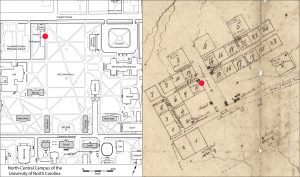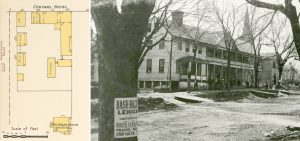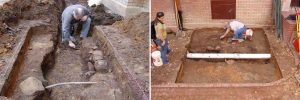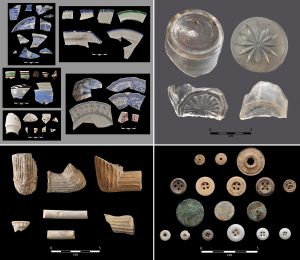The Vance Site

The Vance site is located on old Chapel Hill Lot 11, at the southwest corner of Franklin Street and Grand Avenue (now McCorkle Place). This two-acre parcel was sold by the University trustees at auction on October 12, 1793, and about 1845 it was divided into two one-acre lots. From the mid-1790s through most of the nineteenth century, the eastern lot was the site of a private dwelling. The Roberson Hotel (later Central Hotel) occupied most of this lot from the early 1880s until 1911, when the University purchased part of the lot and erected Battle, Vance, and Pettigrew buildings. The rear portion of the eastern lot remained in private ownership until 1929 when it too was acquired by the University. The western lot is where University Methodist Church now stands.

The image at right shows a portion of the Sanborn Map Company’s 1911 map of Chapel Hill, depicting the Central Hotel and other commercial buildings at the northeast corner of Lot 11 and the Phi Delta Theta house at the southeast corner. Shown at far right is a photograph of the Roberson Hotel (later Central Hotel) in 1894, looking southwest across Franklin Street from the corner of Henderson Street and Franklin Street. The structure that comprises the east (left) end of the hotel may be the same house that was originally built at the northeast corner of Lot 11 by John McCauley in the late 1790s. McCauley and later property owners used the building for both a residence and store throughout much of the nineteenth century.

During renovations of Battle, Vance, and Pettigrew Halls in 2011, construction workers uncovered a deposit of ceramic fragments and broken glassware while excavating to replace a stormwater pipe in front of Vance Hall. Work was temporarily halted while UNC archaeologists excavated a 3×3-meter area between the building and the adjacent brick walkway. This excavation revealed that the construction trench had cut through a nineteenth-century stone drain and cellar pit (view a 3D model below). The first pair of photographs at right show UNC archaeologist Brett Riggs cleaning the partially dug pipeline trench in front of Vance Hall to expose the top of undisturbed archaeological deposits (left photo). In the righthand photo, Brett Riggs is cleaning the top of undisturbed archaeological deposits in the expanded three-meter-by-three-meter excavation after installation of a new white plastic pipeline.

In the second pair of photographs, RLA staff and students are excavating the fill from the shallow cellar pit and the stone drain. The righthand photograph shows the completed Vance site excavation, facing south. The remnant of the cellar floor, intruded by both the stone drain and modern pipeline, is visible in the foreground; the stone drain can be seen in the background. The brick rubble at the right edge of the excavation is the top of the filled-in builder’s trench for Vance Hall.
The cellar pit likely was associated with the private dwelling, built by John McCauley, that stood on Franklin Street at the north edge of Lot 11. It may have been a sub-floor storage facility within a detached kitchen, and the artifacts from the fill indicate that it was filled sometime after 1840. The stone-lined drain can be identified as part of an engineering project designed by UNC professor Elisha Mitchell and built by slaves in the early 1840s. Its fill contents indicate that domestic trash was dumped into it during the following two decades.

Excavation of still-intact portions of the cellar and drain yielded significant information concerning antebellum Chapel Hill. In particular, a large quantity of kitchen and dining debris in the form of animal bone and historic ceramics was recovered. These include most of the fragments from a broken cooking dish found on the cellar floor (view a 3D model below). The style of decoration on this large dish suggest that it probably was made by southern Alamance County potter Solomon Loy and dates to the second quarter of the 1800s. The analysis of these artifacts, along with archival information, provided unprecedented information about mid-nineteenth-century foodways in Chapel Hill. More than 4,500 animal bones or bone fragments also were recovered, and these reflect a varied diet based on domesticated and wild species, including cow, pig, sheep/goat, rabbit, opossum, squirrel, turkey, chicken, mallard, duck, seatrout, bullhead, and catfish.

Other artifacts found at the Vance Hall site and dating to the antebellum period are shown at right and include transfer-printed plate and pitcher fragments, shell-edged plate rims, dipped and banded wares, polychrome hand-painted bowl and cup fragments, glass tumbler fragments, fragments of locally-made clay smoking pipes, English kaolin pipe bowl and stem fragments, and various types of buttons made of bone, brass, pewter, shell, and ceramic.
3D Models of Excavation and Artifact
Vance Hall site excavation
Lead-glazed redware cooking dish
Contributor
R. P. Stephen Davis, Jr. (Research Laboratories of Archaeology, University of North Carolina, Chapel Hill)
*Images courtesy of the North Carolina Collection, University of North Carolina, Chapel Hill.
**Images courtesy of the Research Laboratories of Archaeology, University of North Carolina, Chapel Hill.
Sources
Davis, R. P. Stephen, Jr.
2015 • The Hidden Campus: Archaeological Glimpses of UNC in the Nineteenth Century. Gladys Hall Coates University History Lecture, Wilson Library, University of North Carolina, Chapel Hill, April 14, 2015.
Fitts, Mary Elizabeth, Ashley Peles, and R. P. Stephen Davis, Jr.
2012 • Archaeological Investigations at the Vance Site on the University of North Carolina Campus, Chapel Hill, North Carolina. Research Report No. 34. Research Laboratories of Archaeology, University of North Carolina, Chapel Hill.
